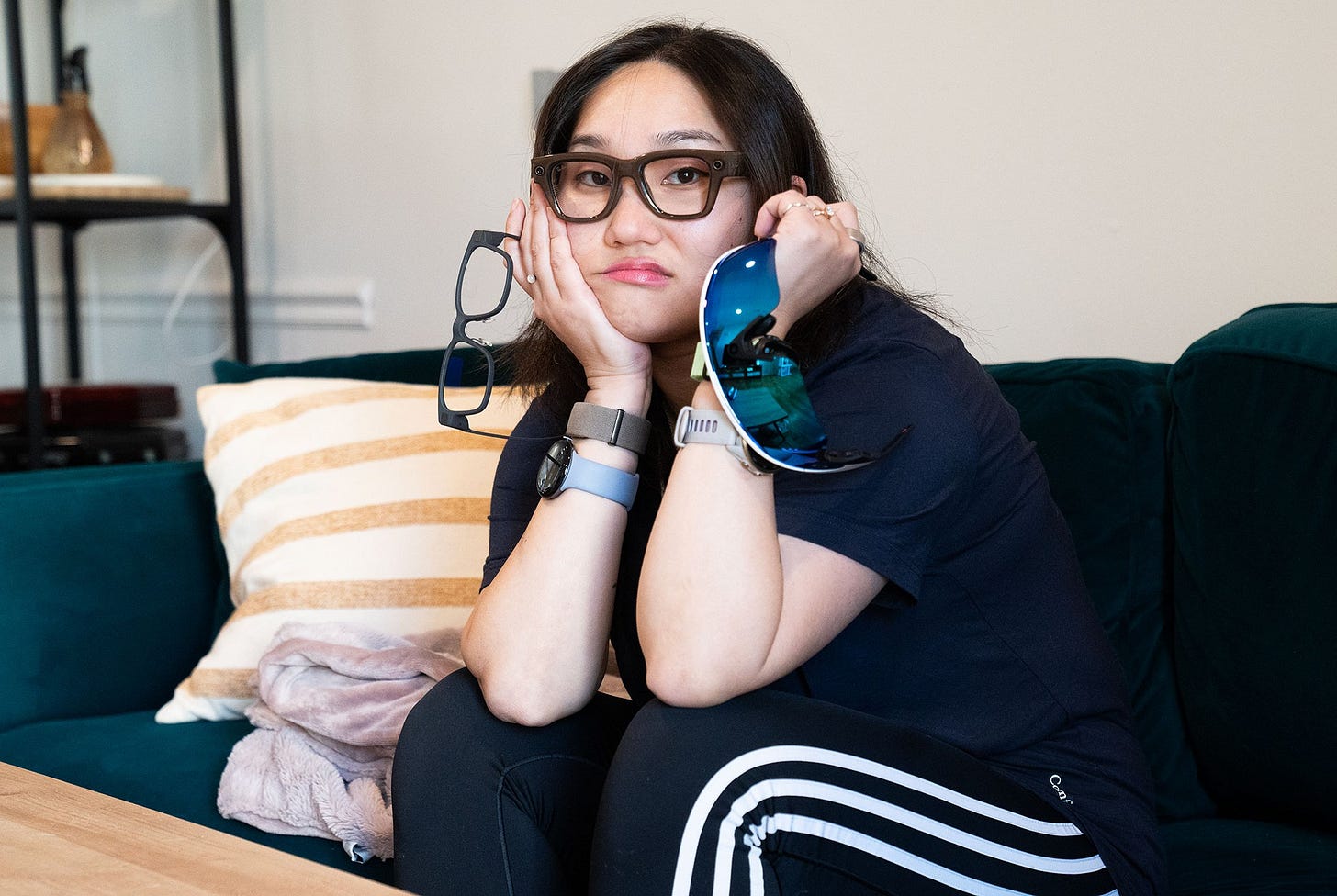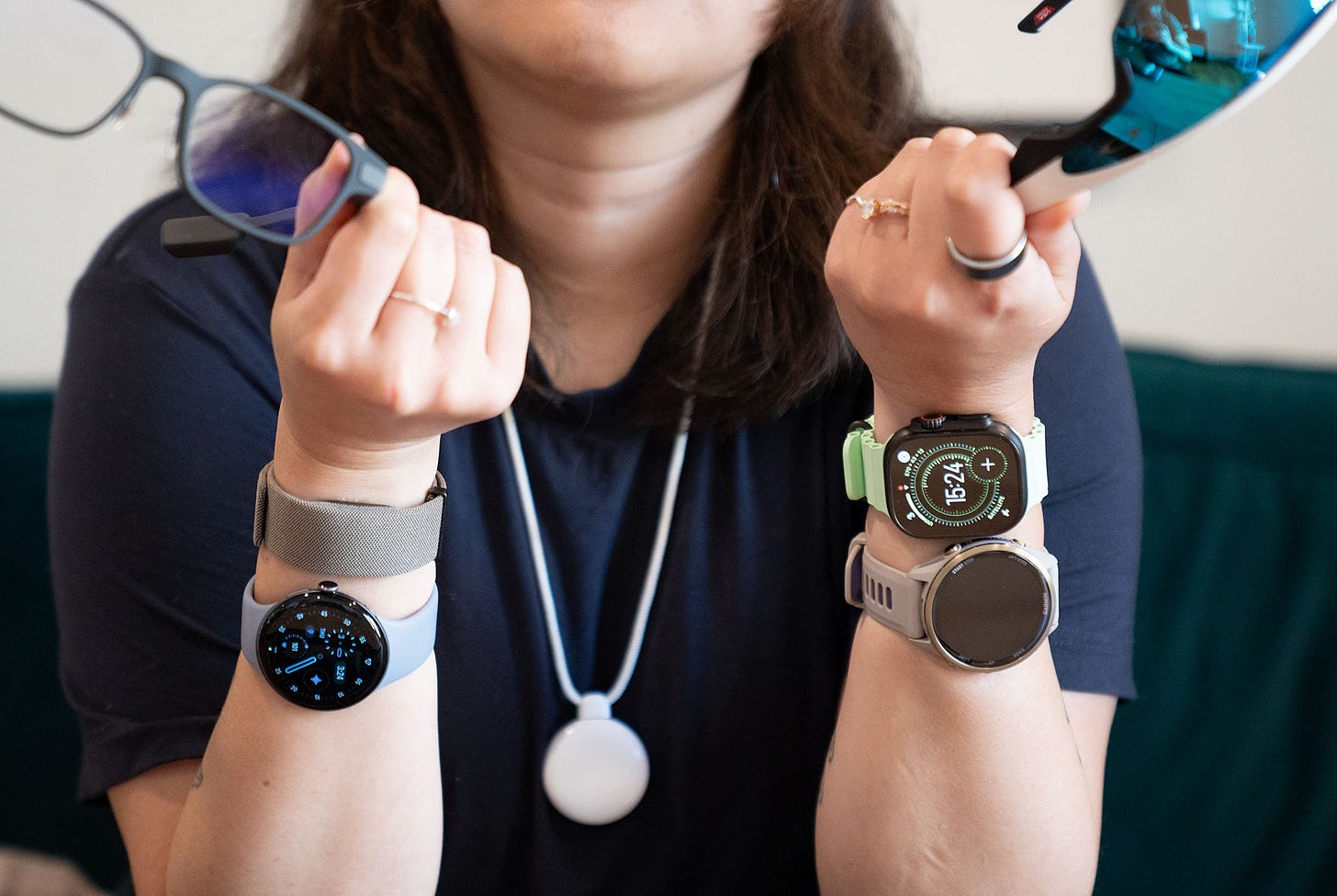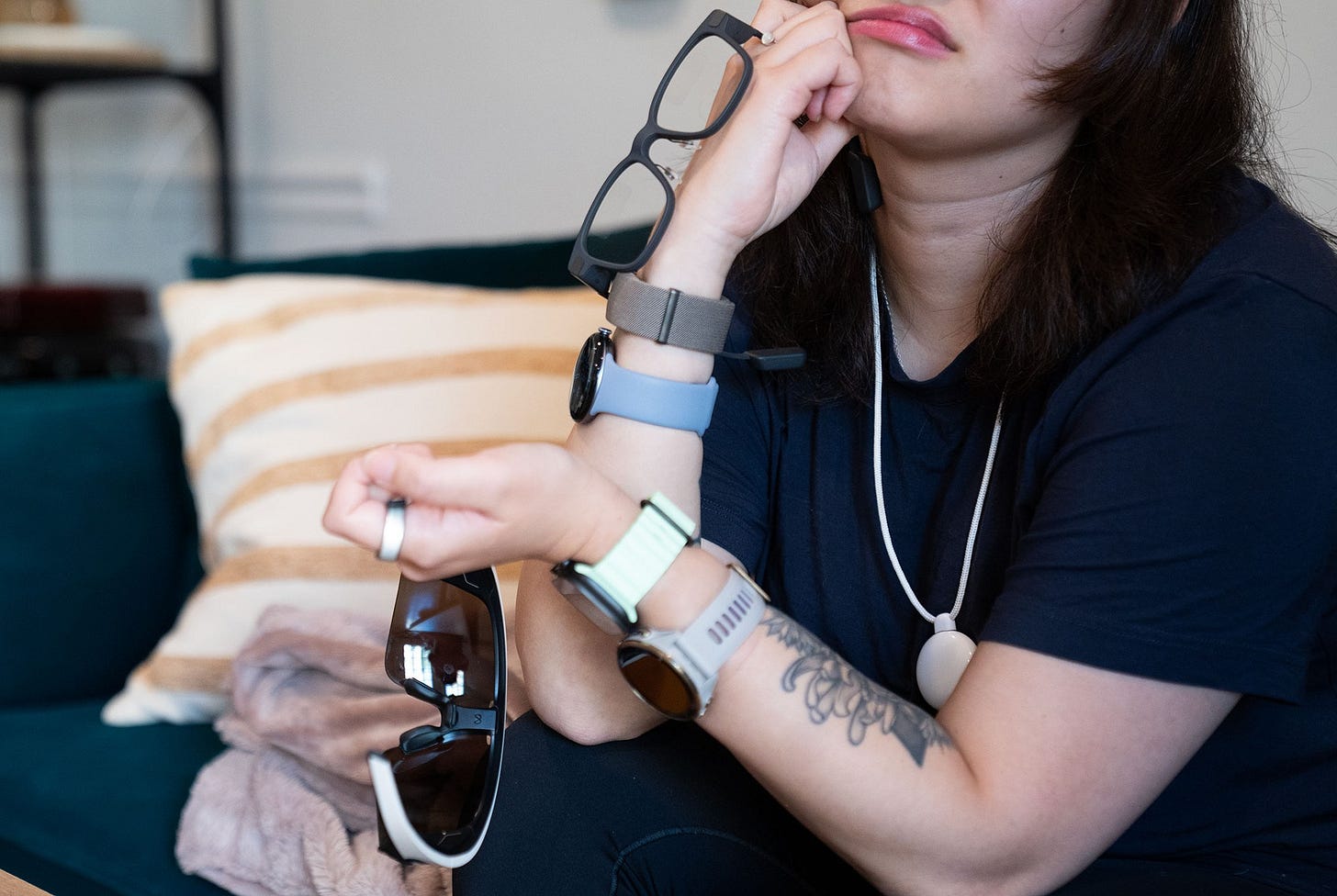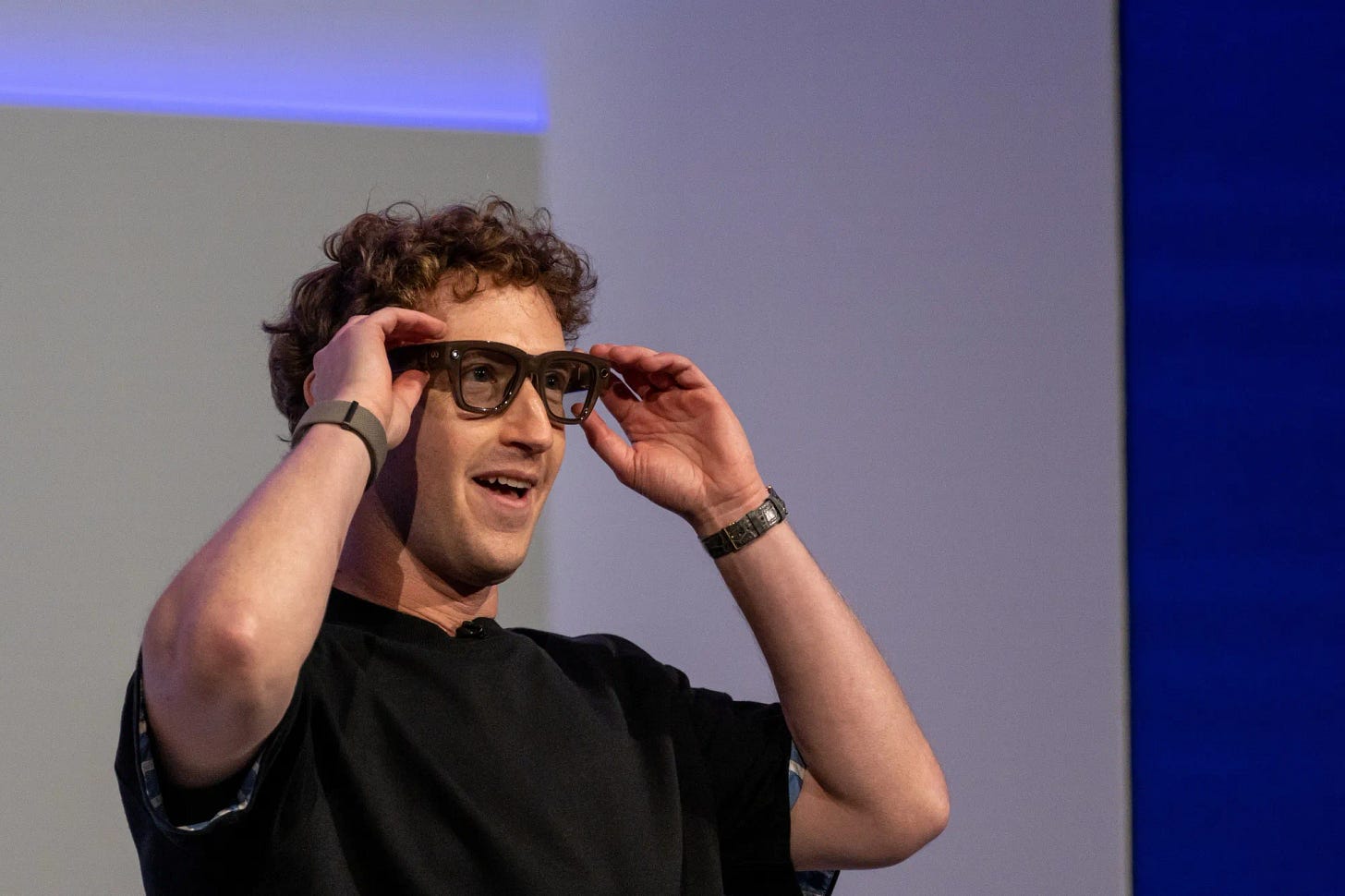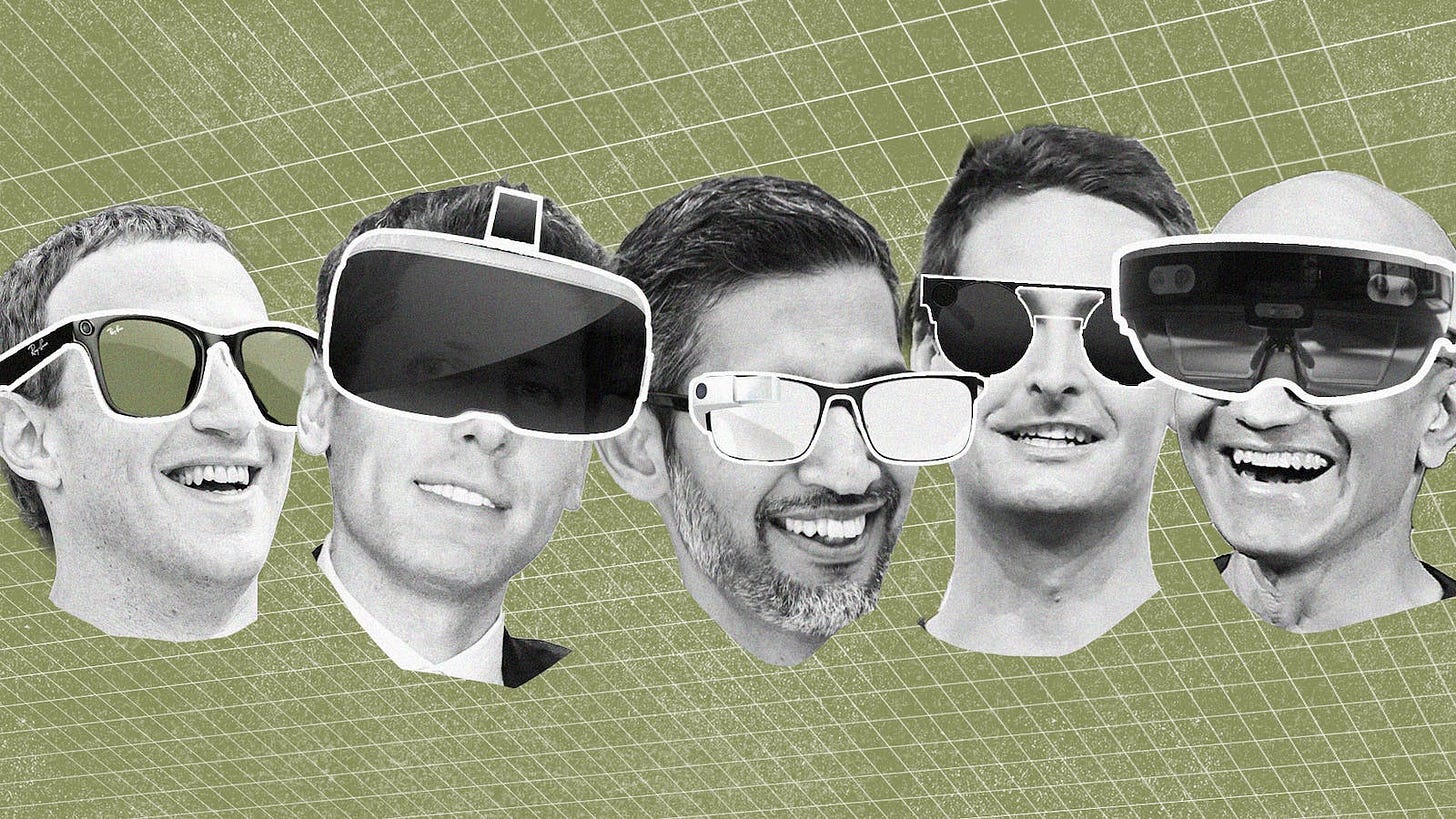AI: The glass half empty on AI Devices. RTZ #872
...the downsides of the flood of AI Wearables today
The Bigger Picture, Sunday, October 12, 2025
The current pitches around AI devices around the corner are all resplendent in glasses far more than half full.
All to boost billions of mainstream users in this AI Tech Wave , way past legacy devices like Smart Phones and PCs. And yet despite the furious and frenetic efforts of Meta, Google, Apple, Amazon , and of course the highly anticipated OpenAI/Jony Ive initiative, amongst many others, it may all take a little longer than anticipated.
That is the Bigger Picture I’d like to discuss this Sunday. The potential glass half empty on so many AI devices to come. Compared to the glass half full case I discussed last Sunday on home bound AI devices.
Much of it has to do with issues beyond the already challenging issues of technological AI hardware and software design. Issues around ‘humanizing AI’ social engineering and anthropomorphizing tendencies around AI devices that I’ve discussed at length.
The Verge’s chief reviewer of AI devices, Victoria Song discusses the socio-emotional side of AI devices in “We’re all about to be in wearable hell”:
“I signed up for wearable maximalism, but with each passing day, I feel more cyborg than human.”
“I had a major problem during the unboxing of my Meta Ray-Ban Display review unit. To control the glasses’ Display, you need to wear a separate neural band on your dominant wrist. That isn’t a problem for most people, but I test wearables for a living. I’m always double-wristing smartwatches. That particular day, my dominant wrist was otherwise occupied by the Google Pixel Watch 4. If the neural band and Pixel Watch 4 couldn’t play nicely together, I was in a real pickle.”
That’s including the AI Smart rings that Victoria was wearing and testing, another area I’ve discussed at length.
“Thankfully, they did play nicely together. The Oura Ring 4 on my right index finger, however, did not. It interfered with the scrolling gestures, so I had to switch it to my other hand.”
“Cue a facepalm that would’ve made Captain Picard proud.”
Cue the ferocious and frenetic pace of new AI wearables to test confronting these professionals:
“Later that day, I tended to the dumpster fire that is my inbox. Various wearable companies had laid siege. Had I finished testing their device? Would I be interested in testing yet another? It’s anecdotal, but in 2025, I’ve been pitched more wearable devices than in any other year in my entire career. I wanted to scream. I only have two wrists, 10 fingers (only six of which are appropriate for smart rings), two ears, a chest, neck, and face upon which to test an ever-increasing number of gadgets meant to be worn 24/7, 365 days a year.”
“For most of my career, I’d wholeheartedly agree that this is a rarefied problem I volunteered for and get paid to deal with. Except in the last two years, I’ve had a sinking feeling that Big Tech increasingly wants more people — perhaps everyone — to live like I do.”
“This dread first snuck up on me when I tested the Samsung Galaxy Ring last year. As I wrote in my review, this was not a device designed to stand on its own. While you could use it as a smartwatch alternative, it’s meant as an accessory for a Galaxy Watch. It’s a means of sucking you into Samsung’s orbit. As smart rings gained steam, an increasing number of friends, family, coworkers, peers, and readers have asked for my read on the Oura Ring. The majority were seeking something comfier and with longer battery life than a smartwatch, but blanched at the idea of giving up glanceable notifications or haptic alarms. Many gave me the stink eye when I said the Oura Ring works best in tandem with a smartwatch, not in lieu of it, for most people.”
“Now sprinkle the recent influx of AI hardware on top of this.”
“Humane’s ill-fated AI Pin was something you wore on your lapel, but couldn’t replace a phone or smartwatch. When I tested Bee, an always-listening AI wearable, I had to decide whether it took up limited wrist real estate or was pinned to my neck. I was somewhat relieved that for all its faults, Friend was something to wear around my neck, a relatively unused body part in wearable tech… so far.”
Everything on our person is fair game for AI gizmos ahead:
“It’s clear to me that in the search for what comes after the smartphone, tech companies have decided they should live on — and eventually, in — our bodies. (See: brain-computer interfaces and continuous glucose monitors.)”
“I wish I could write this off as my paranoia. Unfortunately, you can see signs of it in how tech executives speak about this next wave of hands-free computing.”
“Earlier this summer, I spoke with Sandeep Waraich, Google’s product lead for Pixel Wearables, and Rishi Chandra, Google’s VP of Fitbit and Health. Both told me in plain terms that Google envisions “the future will be a diverse set of accessories” embedded with AI. The appeal of smartwatches and headphones, they told me, was that they are existing products you already use.”
The tech executives in FULL tilt ‘Founder Mode’, are all in on the mainstream possibilities of these devices:
“Similarly, Meta CEO Mark Zuckerberg recently told Sources, “There are between 1 to 2 billion people who wear glasses daily for vision correction. Is there a world where, in five or seven years, the vast majority of those glasses are AI glasses in some capacity?” Meanwhile, Apple is also said to be pivoting toward smart glasses, and it’s no mystery what its stance on product ecosystem is. The more you buy, the better.”
“Add Samsung’s play with the Galaxy Ring plus whatever the heck OpenAI’s Sam Altman and Jony Ive are making, and you have compelling evidence that Big Tech’s power players are all working toward putting as many gadgets on us as they can. It’d be nice if it could be streamlined to one wearable, but the challenge is that no two bodies are ever the same. You’d never snooze with smart glasses to track sleep, smart rings are ill-advised for weight lifting, and smartwatches simply aren’t comfortable for some people.”
This podcast with Meta founder/CEO Mark Zuckerberg gives more visceral sense of this enthusiasm for AI devices like smart glasses.
And it’s causing some blowback:
“Call me a cynic. I fully believe these companies will all tout that you’ll have a choice in which accessories you use, while also making you feel like you’re missing out if you don’t buy everything.”
“It’s not just Big Tech, either. A few months ago, Health Secretary RFK Jr., while speaking about continuous glucose monitors and fitness trackers, said he wants a wearable on every American in four years. Fold that in along with this push toward smartwatches, smart rings, and smart glasses? Welcome to my life, baby.”
“This existential crisis was brought to you by a Vergecast hotline I helped answer earlier this week. The caller asked whether they should embark on a two-smartwatch life. Their Apple Watch alone was no longer sufficient for their regimen of tracking strength training and running. To get the best possible performance, should they add a Garmin and juggle between both products?”
But even the professionals are for now reaching their limit.
Cue this full-throated response as an example this Sunday:
“My answer remains a visceral “Absolutely not.”
“My tolerance for this multi-device hellscape is high, but it’s still a hellscape. Look at me. I live a life of permanent double watch tans, getting negged by AI necklaces, and 30-minute data review sessions every morning when I wake up and after every workout. My eyes hurt from constantly looking at smart glasses displays. (They’re rarely optimally placed!) When I wear CGMs, I end up scrutinizing the impact of every morsel of food that passes my lips. Anytime I get a notification, my body vibrates from various devices eager to let me know that a neighbor has walked past my Nest Doorbell. As I’ve written in a recent Optimizer, I have to build in detox days to ensure I use these tools, not the other way around.”
Victoria voices a key issue at the crux of all this…tech that’s a cool noevlty and can be thrown at the wall, and tech that solves CORE problems with AI stuff to come:
“If the point of all this is to make life better, then I need Big Tech to have a deep, long think about whether the problems they’re trying to solve were ever really problems to begin with. Take it from me, a wearable maximalist: I am exhausted, running out of body parts, and feeling more cyborg than human with each passing day. And if we blindly race toward a future where everyone feels like that? We’ve lost sight of why any of us ever loved technology in the first place.”
For an even more in depth look at just one more AI Device called ‘Friend’, I’d recommend reading Victoria’s “With a Friend like this, who needs enemies?”.
She walks around for days with a snarky AI pendant designed by a 22 year old founder with very strong opinions on how millions should try AI companions. Reads like a dystopian version of the movie ‘Her’. If that’s possible.
This podcast interview of Friend CEO Avi Schiffmann is even a deeper glimpse at the minds that are dreaming up what these AI devices could do in our lives.
Also the Verge’s AI Home Automation lead reviewer Jennifer Pattison Tuohy's “The problems with AI in the smart home” is also worth a full read this Sunday. It’s a contrast to my more positive piece from last Sunday.
“After years of false starts, the promise of ambient intelligence has arrived, but will it be worth the price?”
I point all these pieces out to emphasize how many non-engineering and engineering hurdles have to be solved to take AI Devices into the true mainstream of hundreds of millions and eventually billions of users worldwide.
These qualitative issues are a total part of the Bigger Picture around AI Devices in this AI Tech Wave. Despite all the enthusiasm and billions that tech companies big and small are leaning into them currently.
So the glass half empty on AI Devices in all their forms, needs to be kept in mind along with the half full. Stay tuned.
(NOTE: The discussions here are for information purposes only, and not meant as investment advice at any time. Thanks for joining us here)


